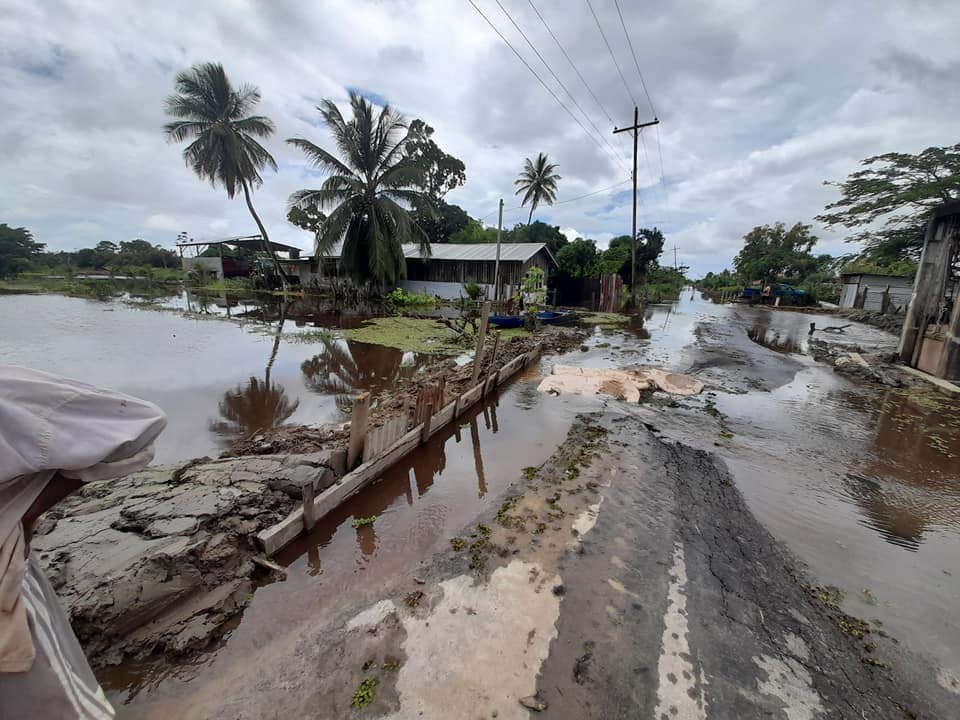Flood-hit communities in regions Five and Ten have seen a drop in levels and residents remain optimistic that within a short period the water will be gone from land.
It has been just over a month since residents of the Abary, Mahaicony and Mahaica rivers in Region Five and Kwakwani, Aroaima, Lamp Island and others in Region Ten, have been inundated.
Councillor of Region Ten, Elroy Adolph yesterday informed that water levels have receded by approximately eight inches.

He stated that they noticed the water levels receding off the land slowly over the weekend but pointed out that they have been experiencing light showers across the region.
“It is funny how this works, the water comes with the rain and goes when the rain goes [rainfall stops]. We keep hoping that the water will move off the land soon enough and we can return to our normal lives,” he said.
Adolph mentioned that the shelters are still occupied as even though the water level is dropping, there is “still a lot of water on land.”
“They cannot move out of the shelters as of now because they have nowhere to go. The water is still high on the ground but it has dropped and we hope it continues to drop,” Adolph said.
Asked about food supplies and access to water, he stated that with donations pouring in from the private sector and government agencies, there is no immediate threat to food security. He noted too that the water treatment facility in the district has given all assurance of having an adequate amount of water in storage to serve the community.
“You know we are very thankful for all the assistance we are being given. We are truly grateful because we understand how difficult it is to help in a crisis. But we are extra thankful because people are finding means and ways to help us in a global crisis. We just have to say thanks,” he said.
Moreover, the Regional Councillor said that several residents have signalled their intention to move to higher ground and will like to commence construction soon after the flooding. He opined that a team from the Guyana Lands and Survey Commission should visit and execute a survey so as to determine the best possible area for development.
“They should come now and start surveying and plotting lands because it can be foreseen that as soon as the floods is gone, people will want to squat. We should seek to avoid that,” he warned.
Meanwhile, Vickchand Ramphal, Chairman of the Region Five Regional Democratic Council, yesterday said that the water from the riverine communities has receded by at least two inches. However, communities like Wash Clothes, Mahaicony, and Big Baiboo, Mahaica, remain waterlogged.
He explained that the water has been slowly receding and they are continuing to monitor the impacts. Ramphal said too that a flood assessment and survey should commence shortly in the region.
He however noted that food and water are still being supplied to affected residents and recently agencies such as the Guyana Livestock Development Authority have distributed bran and other animal feeds to livestock farmers.
“With the water level dropping, a significant amount of farmers have been able to move their cattle to higher grounds. So we are not having so much deaths now,” he related.
He also explained that the Mahaica, Mahaicony, Abary-Agricultural Development Authority and the National Drainage and Irrigation Authority have been continuously monitoring and constructing defensive dams to prevent further flooding.
Minister of Local Government and Regional Development, Nigel Dharamlall on Monday said that the government will be commencing a survey of flood damage.
“As a matter of fact tomorrow [today] an assessment team will be in Region Six to start doing the assessment in terms of your losses whether it is agricultural, and agricultural includes crops as well as livestock,” the minister informed.
Dharamlall stressed that he would be going around to the 70 neighbourhood democratic councils in the country as well as the ten towns. “I have to go and make sure that we do the physical assessment of what needs to be fixed and addressed during the course of the recovery after the flood.”






